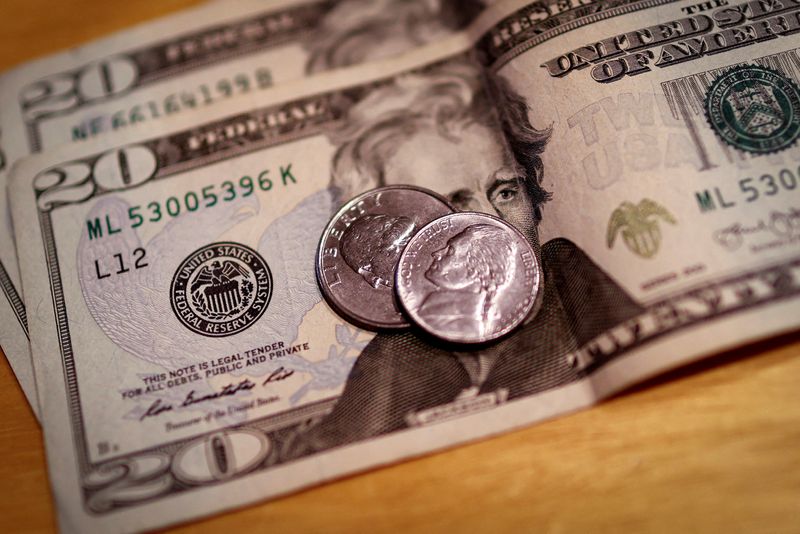
By Jamie McGeever
ORLANDO, Florida (Reuters) – The only “winner” from a possible all-out trade war between the West and China will probably be the U.S. dollar.
Uncertainty around global trade policy is the highest since 2018-2019 when clashes between former U.S. President Donald Trump’s administration and Beijing reached fever pitch. It’s nowhere near those peaks yet, but will be the focus of greater attention as the U.S. presidential election draws closer.
Whoever wins in November, further tariffs on imports from China and likely retaliation seem inevitable. China already warns that a move by Europe to join the tariff train would constitute a “trade war.”
Trump’s return to the White House would raise the stakes significantly.
Rising protectionism and shrinking cross-border trade may dampen growth everywhere but the U.S. – the world’s economic and currency superpower – has layers of protection that other countries don’t.
These include the relatively closed nature of the economy, the global importance of U.S. equity and bond markets, and the ubiquity of the dollar in international reserves.
That’s not to say the U.S. won’t suffer – growth would slow and inflation might rise. But higher inflation delays or possibly eliminates Fed interest rate cuts, and growth in Europe and Asia would be more vulnerable than in the U.S.
In short, the pain is likely to be felt more acutely in other currencies, none of which have the dollar’s safe-haven status either. And in the world of exchange rates, everything is relative.
THREE TIMES THE HIT
Goldman Sachs economists attempted to quantify the risks to U.S. and euro zone growth by analyzing the 2018-2019 trade war and beyond through three lenses – U.S. and European company commentary on trade uncertainty, stock returns around tariff announcements and cross-country investment patterns.
They found that a rise in trade policy uncertainty to 2018-2019 levels would likely lower U.S. GDP growth by three-tenths of a percentage point. The estimated hit to euro zone growth would be three times greater.
For a region already expected to grow significantly slower than the U.S., at only 0.8% this year and 1.5% next year, according to the International Monetary Fund, that would be a major blow. Aggressive monetary easing from the European Central Bank could follow, undermining the euro.
“Further increases in trade policy uncertainty pose meaningful downside risk to our global growth outlook in 2024H2 (second half of 2024) and 2025 … with larger effects in economies where exports account for a larger share of GDP,” Goldman’s economists wrote on Tuesday.
CLOSED OFF
The U.S. economy is far less open than its European or Chinese counterparts, meaning disruption to trade should have a relatively limited impact.
U.S. exports of goods and services accounted for 11.8% of GDP in 2022, according to the World Bank, compared with 20.7% in China. Eurostat data shows that euro zone goods exports last year were worth 20% of GDP.
A persistent and deteriorating trade deficit for years was seen as a major drag on the dollar as the U.S. had to suck in huge amounts of foreign capital to plug the gap and prevent the dollar from falling.
But the U.S. trade deficit last year was 2.8% of GDP, much smaller than the year before and half of what it was in the mid-2000s. Onshoring, energy self-sufficiency, and a push to revive domestic manufacturing all indicate the deficit will not be the drag on the dollar it once was.
And that’s before any tit-for-tat tariff escalation potentially shrinks U.S. imports further.
EURO PARITY?
China’s domestic economic problems and geopolitical stance are enough to make foreigners wary of investing in the country. But it’s no coincidence that foreign direct investment flows into China are plunging at their fastest pace in 15 years right as trade tensions percolate again.
Chinese stocks are underperforming, barely in positive territory for this year and after a dire 2023. Beijing is struggling to hold up the yuan, which is at a seven-month low against the dollar.
European stocks and the euro have not reacted favorably to recent headlines about the tariffs Brussels is slapping on certain imports from China. Given how close trade ties are now between the euro zone and China, this should be no surprise.
The euro zone imports more goods from China than anywhere else in the world, and the yuan’s weighting in the trade-weighted euro rivals that of the dollar. Trade tensions between China and Europe will hit the euro hard.
And with the euro having a near-60% weighting in the broader dollar index, there is a naturally strong inverse correlation between the euro’s fate and the dollar.
Analysts at Deutsche Bank predict that the dollar will stay “stronger for longer” this year and into next year, although momentum may fade as the cycle gets longer in the tooth.
A more belligerent stance on trade from whoever wins the White House in November, however, would be a major dollar-positive development and probably push the euro back down towards parity.

“The dollar is under-pricing risks from U.S. protectionism,” they wrote on Wednesday.
(The opinions expressed here are those of the author, a columnist for Reuters.)
(By Jamie McGeever; Editing by Paul Simao)
This post is originally published on INVESTING.






